Killeigh Parish
Main menu:
- Home Page
- Parish Newsletter
- Parish Calendar
- Local Services
- EMIGRANT ADVICE
- Cemetery Stones
- Local News
- Ballinagar New School
- Easter Mass on Mountain
- Killeigh Renovations
- 50th - Cloneygowan
- 17th June 2012
- Geashill Old School
- Gooseberry Fair
- Mother and Toddlers
- CYMS Golden Jubilee
- 2 Threshing days
- Killeigh Vintage.
- Ballinagar Old School
- Water Scheme Wells
- Mick the Miller
- Ballinagar Church
- People of our Parish
- Mass Times
- Safeguarding
- Getting Married
- YouTube Pieces
- Sports Clubs
- Useful Links
- Diocesan News
- History & Heritage
Bishop Mahon
Local News > People of our Parish
BISHOP JOHN C. MAHON (1922-2004)
Bishop John C. Mahon was born in Ireland on Christmas Day 1922, and was ordained a priest of St. Patrick’s Missionary Society on Easter Sunday 1948. After obtaining a Doctorate in Canon Law, he taught in St. Patrick’s Seminary, Kiltegan, Ireland for eight years. He was then appointed to the Diocese of Ogoja in Eastern Nigeria in 1959, where he worked until his appointment in 1968 as the Prefect Apostolic of the newly established Catholic Prefecture of Lodwar. The area became a Diocese in 1978, with Bishop Mahon as its first Bishop. He served there until his retirement in 2000.
When Bishop Mahon came to Lodwar in 1968, there were only two Catholic Mission stations, Kakuma and Lorugumu. Now the Diocese has 22 Parishes, with vibrant Christian communities. Under Bishop Mahon a network of schools, health services and water installations was built up among each community, with irrigation and fishing projects along the Lake. He made sure that every parish was associated with some humanitarian service to better the lives of the people of the drought-prone Turkana District. He received an award from the Daily Nation in the year 2000 for his work in receiving and distributing the famine relief that was very generously donated by the people of Kenya in response to the Daily Nation appeal at the time.
Bishop Mahon’s 32 year apostolate to the people of Lodwar was characterised by these strenuous efforts to combat poverty and underdevelopment in this very arid part of Kenya. He also stood up courageously for the rights of the Turkana people at all times. He was at the same time a very modest man, who never sought any attention for himself personally, and was very much a hands-on type of administrator.
Bishop Mahon returned from visiting his family in Ireland on Friday 5 of November and died very peacefully five days later in Nairobi. It is very fitting that he should be buried in the soil of Turkana where he served the people with complete dedication and devotion.
Interview with Bishop Mahon: [From 'Africa']
Not all stories, even missionary ones, are "rags to riches" stories.
In this interview with the Editor of 'AFRICA" Bishop John Mahon from Killeigh, Co. Offaly tells us the story of a difficult mission.
BISHOP OF TURKANA
Editor: Bishop Mahon, you are now Bishop of Lodwar, Turkana, in Northern Kenya. Have you always worked in Lodwar Diocese?
Bishop Mahon: Oh, no. I only went there as I got on in life. l taught for a while in the '50s in Kiltegan before going to Nigeria. From I959 I spent about nine years in Nigeria, and during the Civil War there I was moved from Nigeria to Kenya to take over as Prefect Apostolic in the newly erected Prefecture of Lodwar. So it was in I968 that I went to Turkana, Lodwar.
Ed: When you were teaching in Kiltegan did you notice any particular expansion in the Society, any new directions?
Bp: Well, big numbers continued to join us after the initial class of 27 in 1941 of which I was a member. The following year there were 25, the year after that probably in the region of 30. Those big classes continued in my time and during my period in Kiltegan. So we continued to expand and all kinds of plans were laid for further expansion, the building of a new College in Kiltegan and the opening of our House of Studies in Cork to cope with these expanding numbers. I don't think there was ever any thought that we could ever diminish at any time.
Ed: And was it during that time that the Society moved from working in Nigeria alone, to Kenya?
Bip: Yes, the mission opened up in Kenya in I95I. With the increasing numbers, I suppose we felt it was important to look for new missions and it was an era of expansion in Kenya also. As to why a place like Lodwar would ever have been set up as a separate jurisdiction I can only conjecture. First of all, I would say Lodwar is a very impoverished, barren, desert country and I suppose if ever development was to take place there it really had to be made an independent jurisdiction. I also would think that Rome would have been concerned about the spread of Islam from Sudan and that they wished to strengthen the Church in Northern Kenya and thus contain the advent of Islam from Sudan.
Ed: Could you tell us, more or less, what you found when you arrived to take up your onerous task in Lodwar?
Bp. Well, I cannot say that everything was completely new to me. I would have heard a lot of talk about Turkana but I was not quite prepared for the picture that I saw when I arrived. It was such an impoverished area with nothing growing. I had been told, yes, it's a desert country, but the barrenness of the thing was striking after coming from a relatively fertile country like Nigeria where at least the people were able to look after themselves. Here I was placed in an area where no crops grow, where the only thing that supports life is a rudimentary kind of vegetation, a rough grass and rudimentary shrubs, and that was what kept the people in existence.
Ed: Had you any idea of the numbers of people in your new ecclesiastical area?
Bp: I imagine I would have had some statistics for the area but even now the statistics from Lodwar are very unreliable. The general idea was that there were about 100,000 people. As far as the mission effort was concerned we just had two mission stations. There were five priests and five sisters and that was the total resources of the diocese. I think there wouldn't have been many jurisdictions set up in the Church with such poor resources as Lodwar had at that time.
Ed: Did Rome give you any facilities or resources to help you begin this new Prefecture?
Bp: Yes, we did get a grant from Rome specifically to build a house. While we had two mission stations we had only one mission house and we got a grant from Rome to provide a place for the new Prefect to live and in the following years we got a small grant to erect some churches.
Ed: Had you any idea what you were going to do when you arrived or how long did it take you to work out some kind of plan to help you to move forward?
Bp: Well I had to be guided by the men who were on the spot and even now, over 20 years later, I don't think we have the answer for the evangelisation of the nomadic people. -I don't think we, coming in from outside, are capable of being nomadic missionaries. As far as the pastoral work of the Church is concerned we just did what we knew from our experience and work in Nigeria; we set up mission stations and we became involved in education and in social work. We realised that the people were nomadic but we were not able, I think, to know how to follow them, to stay with them. The men who were there when I arrived were very anxious, even though the Church there was very young, for me to start a secondary school because they felt that was something that would give us standing in the area and they felt we must have an educated group if there is ever going to be development or progress, spiritual or material, in the area..
Ed; How did you find the people themselves took to Christianity -to the Word of God, with that set-up you've just described?
Bp: One of the great problems facing the Church in Turkana, even today, is the fact that the Church appeared among the people in Turkana as an organisation that came to solve their economic problems, i.e. their hunger problems, and until we are able to shed the image of a Church which has come among them to serve their economic needs, then we are not going to have a true Church there.
Ed: This problem was compounded by the fact that shortly after your Prefecture was set up; a devastating famine came in that area. Is that not true?
Bp: Yes, and the Church was invited in, by the Government of the day. The reason for that was that Northern Kenya, specifically Turkana area, was a "closed" area. Expatriates weren't allowed to reside in that area without special permission because in colonial times it was a closed area. The Government would not allow people in, because it didn't want to be concerned about, or looking for, people who got lost in an area where there was no water, no food, no petrol and no roads. So the simple answer was for the government to keep them out. Then when this great famine occurred in 1960 - '61, the Government felt that they had to do something for the people that were dying and we were allowed to come in and look after the distribution of food and provide a medical service for the people.
Ed: So what were the early difficulties you encountered in bringing the Word of God and sharing the Word of God with people under your care?
Bp: It's very hard to expect people to listen to you, no matter how attractive your message may be, if they are hungry. Because of that problem we became very development-conscious in the area and we have done a lot, and perhaps more than you'd expect, in Lodwar/ Turkana to try to improve the material well-being of the people, because for sure the life there is extremely grim and even after 20 years living among the Turkanas I still wonder how they survive. Now for the people, for six years out of seven life is very, very grim - hunger is never far away. It's a kind of a constant companion there. I felt that people, who were so impoverished, in such dire straits, were not going to listen to our message unless we showed them our practical concern. Our first years there were spent feeding the hungry, without much fanfare or awareness by the "outside" world of what we were doing.
A Description of the Ceremony of Episcopal Ordination in Turkana
THERE ARE times in life when we have to believe also in what we can see and touch and experience. Even for the missionary there may still be the rare, the extraordinary, the once-in-a-lifetime, the historically once-ever, experience; and he has to ask himself 'is this really happening?'
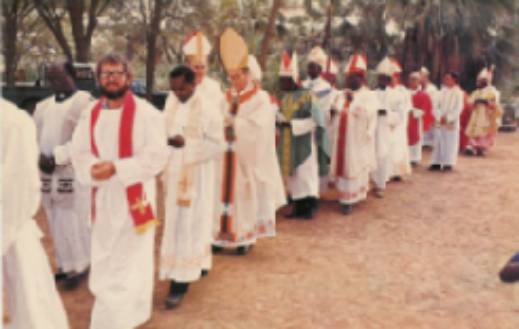
Not that it was extraordinary that John Mahon, of Killeigh, Co. Offaly was ordained first Bishop of Lodwar, Kenya, on 25th April. It was simply the event of it.
Even for the Kenyans, seeing this part of their own country for the first time, the wastes of sand and volcanic rock that make the Turkana desert, seemed like another country, another planet almost. At the edges of Uganda and The Sudan, this Rift Valley desert was indeed for many at the ceremony ---the uttermost part of the earth---.
In lorries, by landrover and on foot they came, six thousand people. In a faultless operation organized by Fr. Joe Moran (Westmeath) and Sr. Sean Underwood (Boston) a flock of light aircraft, like giant birds to the wonderment of the desert people, flew over, circled in and touched down. Cardinal Otunga and the entire Kenyan hierarchy came.
Fresh from Killeigh, Dublin, Portarlington, Tullamore, Coventry and Devon came twenty-two members of the "Mahon family---. Fr. Billy Prendergast, parish priest of Killeigh, came bearing the gift from the home parish of a gold, Celtic pectoral Crosier. Long-time curate of Killeigh, Fr. Tom Donoghue, parish priest of Rosenallis, was there. Representing the Irish Church came Bishop Dominic Conway of Elphin. And from other faraway places came a trickle of people - from Rome, Nigeria, Kiltegan, Louisiana and Holland.
Turkana never saw, anything like this. Not quite 17 years ago, the two Kiltegan pioneers, Frs. Joe Murray (Meath) and Ray Murtagh (Down) journeyed into the desert, with a tent, on a famine-relief mission. Since then, this proud, independent race of nomads took a long, long look at these white men who came, and others who followed like Fr. Michael Brennan (Kilkenny). Somehow Christianity must have got through to them, when most other things of the modern world failed to impress them. As a team of us helped to distribute Holy Communion at the Ordination Ceremony, I could scarcely believe that a thousand, surely, received Communion. Old women dropped on their knees in the sand in ecstatic prayer, and one just had to walk round them. That Lodwar should have, in so short a time, become a diocese of 6,000 Christians is for me the desert miracle: something like the events in the Early Church after Pentecost, or at Slane and Tara when Patrick came. Only that Turkana is a far more improbable place for such a happening.
I have been at other Episcopal ordinations. Here at Lodwar the landrover was our vesting bench, in the shade of the 'Ngiwoo' tree. Cardinal, bishops, and 85 priests processed through the crowds to the open-air ceremony. The impressive liturgy at times erupted in marvellous Turkana participation. St. Paul to the Ephesians came alive for us in the old, unwritten, Turkana language few of us understood. With one finger held high in the air, ancient Turkana men, squatting on the sand, took up and renewed the readings. ---There is one Body, one Spirit, just as you were called into one and the same hope", they chanted vigorously.---There is one Lord, one faith, one Baptism, and one God who is Father of all, over all, through all and within all", they emphatically proclaimed.
For a tribe lacking musical instruments of any kind save the drum and the human voice, a glorious symphony of harmonies, rhythms, counterpoint, trailing echoes, chorused humming, drums and hand-clapping row to the blue sky. The litany at the Prostration was electrifying.
"Ooooool Topia topia teals, topia, topia Akuj ekile Is. mmmmmm! . . . . Bless, bless, bless, bless. God bless this man ... The Holy Spirit has brought Monsignor Mahon to us ... Yes, he is fit for this land ... My heart loves our spiritual leader.--
Fr. Tony Barrett (Mayo) and Sister Clotilde O'Doherty 0.S.U. (Sligo) had done a marvellous job in preparing the singing and the liturgy.
At the offertory procession, what matter if one or two goats ran amok; this was all strange to them. They were swiftly and literally brought to heel, Turkana style, and the whole herd (70) continued their somewhat disciplined procession. The elders of Kakuma, in the far North, presented a special shepherd's crozier, a spear and a shield, and showed Bishop Mahon how to protect himself. About then, Fr. James Good passed round the drinks (water, of course). It was 90. Fahrenheit.
Maurice Cardinal Otunga, Archbishop of Nairobi was the ordaining prelate, assisted by Bishop John Njenga, Eldoret, and Bishop William Dunne, Kitui.
At the end of the day, two hours before sunset, the exodus of small planes began. Bishop John Mahon saw them go, just as he had watched them come. Back across the dawn, over the West Pokot Hills, and the Sekett Range, and the Karasuk Hills they flew carrying the dignitaries - back to the famed Highlands and to one of the loveliest countries in the world.
Next day I came across Bishop John mending a puncture in the landrover. Later, the pump in the borehole 80 feet deep, the life-line to the village of Lorugumu, gave out. He was back to lowering improvised clamps, hauling up the faulty mechanism, trying to avert even yet another desert crisis ... and running his diocese again.
Desert Diocese By Fr. James Good
The Turkana Desert of northwestern Kenya must be one of the last places in Africa to receive the Good News of the Christian gospel. On December 8, 1961, two St. Patrick's Missionaries arrived in Lodwar, in the very centre of the desert, to manage a famine camp set up near the town to house the thousands of Turkana nomads who were already dying of hunger in this "dry weary land without water'. Strangely enough, they came at the invitation of the British colonial authorities, who had up to this time declared Turkana a "no-go' area for missionaries.
Fathers Joe Murray and Ray Murtagh had a difficult task ahead. This once proud warrior tribe was now reduced to about 35,000 desperate hungry people. They had no health services and no schools, and their religion had no contact with Christianity, apart from the version they saw in their colonial masters. The nearest town - if it could be called a town at that time - was Kitale, more than 200 miles distant, and linked to the desert by a road that often disappeared into the desert sands or was controlled by bandits.
Eventually the famine camps were closed, and the Turkana people once more went back to their nomadic way of life. The colonial authorities now suggested that the missionaries' work was done, and that they should depart. But the young mission had already taken root: schools had been set up and health centres were operating (under the Medical Missionaries of Mary). The mission to the Turkana was already well under way.
Soon it was obvious that the new mission called for a government of its own. Hitherto it was part of the S Diocese of Eldoret, a diocese more than 500 miles in length, stretching from southern Kenya up to the Sudan border. In I968 the desert was separated from the Diocese of Eldoret and established as a Prefecture Apostolic - not yet a full diocese, but on the way to becoming one. Its first Prefect Apostolic was Monsignor John Mahon of St. Patrick's Missionary Society.
Soon after arriving, Monsignor Mahon made an assessment of his resources. Under Lorogumu - the site of the famine camp - he noted a full primary school, which was rare in those days, as primary education (where it existed) generally stopped at standard four. He had a six-bed dispensary and a homecraft centre. For out-stations, he had the Turkwell Irrigation Scheme with its school, and Lorengippi, a water spreading scheme, 30 miles to the south. There was nothing else to boast of except a desert the size of Ireland, which an early writer described so well.
“It was and still is a horizon less frying-pan of desolation: a sun-dried moon-scape of cracked earth harder than iron, grotesque lava heaps rising to the height of ten-storey buildings, Vast plains of dehydrated thorn scrub, sightless deserts and scorched black mountains. Temperatures often climb to 120 degrees in the shade (when shade can be found), and such articles as brass cutters and belt buckles will sear the flesh after an hour in the sun, Thirst is the traveller's closest companion. The country may have been described best by the late journalist, Negley Farson, when he called it 'as close as you can get to hell on earth'."
(Charles Miller, The Lunatic Express, p,47I)
Monsignor Mahon was soon joined by a young and enthusiastic group of missionaries. Further mission stations were set up, each with its primary school and dispensary. Kakuma Hospital developed over the years into a fine institution, which was serviced by visits from the Flying Doctors from Nairobi. The Ursuline Sisters, who had already done so much under Sister Clotilde O'Doherty for primary education, now moved into the secondary field, with a fine establishment at Lorogumu. Numerous missionary societies joined in the work by sending one or a few priests to support the Kiltegan initiative. Volunteer priests, Sisters and Brothers came, with an occasional diocesan priest, to swell the ranks. In the 10 years between 1968 and 1978 the development of the Prefecture was so encouraging that the Holy See decided to raise it to the level of a full diocese.
The ordination of Monsignor Mahon as first bishop of Lodwar on April 25, 1978, was a never-to-be-forgotten event. The newly-appointed bishop took as his Episcopal motto, ‘Domino ne moreris’, Lord do not delay (Psalm 40:17). About 6,000 people attended the ceremony, held in the open air in a stadium beside the great River Turkwell, the only river which flows all through the year in the desert. Afterwards, roast goat and posho (ground maize) was served to all, with a special lunch in the secondary school for the VIPs.
Developments after 1978 are too wide and too numerous to mention. Communities of African priests and Sisters gradually replaced the lay volunteers
It would be unkind to mention only some of the heroic men and women who made the Turkana mission what it is today. All who have worked for the coming of the Kingdom in Turkana would have to be listed.
It was eminently fitting that papal authority extended the Episcopal ministry of Bishop John Mahon for more than two years beyond the stipulated term. Bishop Mahon had worked in Turkana for 32 years when a new appointment was made. He had seen the joys and the sorrows that many a bishop had seen, the successes and the failures, the hopes dashed, the goals achieved. Perhaps Bishop Mahon's greatest sorrow was the premature death of his first and (at the time) his only Turkana priest, followed soon after by the death of another young diocesan priest, Fr. Maurice Imoli.
On March 20 this year Rt. Rev. Patrick Harrington, of the Society of African Missions (SMA), succeeded Bishop Mahon as bishop of Lodwar. Bishop Harrington brings to his new post outstanding administrative gifts, with a readiness to listen to the views of others. With his appointment, the Diocese of Lodwar and its Turkana people can look forward with confidence to a continuation of the great work done by Bishop Mahon and his fellow workers in a lonely and difficult mission in the Turkana Desert.
Funeral of Bishop John
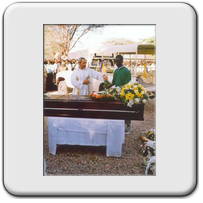
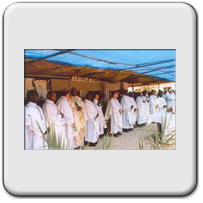
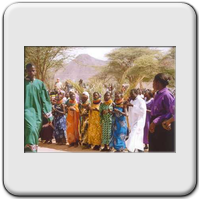
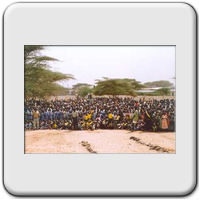
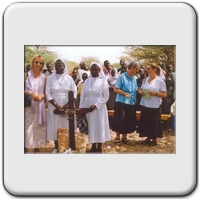
Sub-Menu: